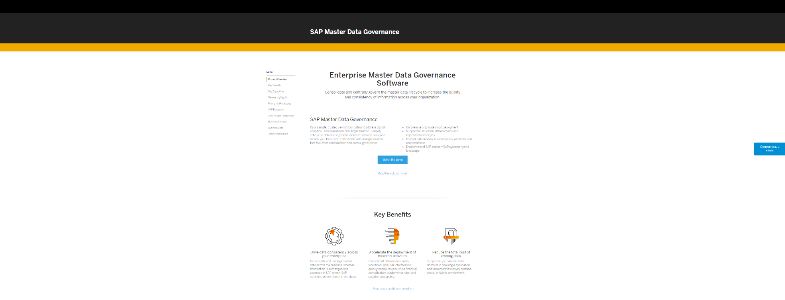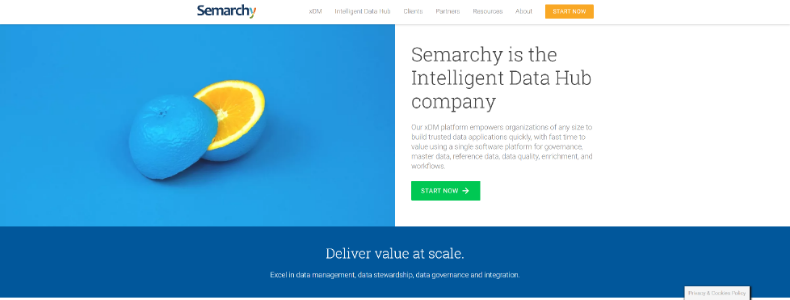Top 11 Master Data Management (MDM) Software Providers
What is Master Data Management? The phrase ‘Master Data Management’ sounds very ‘techy’ and complicated, but in simple terms it just refers to the management of your master data files. You may have a master data management system in-place already and not realize it. Even the most simple customer management systems can be considered master data management (MDM) – as long as all the necessary information is recorded and can be extracted from the same system.
By now, you are probably starting to realize how crucial a good data management system is. Think about what a nightmare it would be if your customer orders and returns were not handled in the same system. Sure, you would easily be able to figure out your overall net income minus returns, but imagine how hard it would be to deliver great customer service; and what about tracking inventory or product performance?
The best master data management systems offer you a way to form (and regulate) business rules and controls based on the data stored within them. Once you understand the methodology, the benefits of a Master Data Management method become obvious. These systems can help prevent fraud or critical business errors, but most importantly, an effective MDM program can help your company run more smoothly and efficiently.
It is important for small companies to be setup with a good data management system, but for large corporations, it is absolutely crucial. This is because larger companies tend to handle more, and more complicated, information.
When dealing with data management for large corporations, the biggest challenge comes when companies merge (or if one acquires another). Most likely, each will have its own MDM and the two will have to be merged. Normally, this problem is anticipated ahead of time and a database administrator is brought on to help with the merge. His job will be to remove duplication that has occurred as a result of the merger. However, because of the dependency of each company on their master data files (often they cannot run efficiently even for a day without them), usually the database administrator will only be able to complete a partial merge. Though merging databases can be tricky, it is not unusual for a large corporation to want to acquire a smaller company for the sole purpose of obtaining their customer database.
Most master data systems contain a few separate lists that are shared by several applications. You may have a Product (or Item) Master, a Customer Master, and an Account Master. It is important to properly manage these lists within MDM so as to avoid errors. Such errors may be leaving your company open to billing, shipping, and customer service headaches. Let’s not even think about the harm an error in an accounting file could cause. You could miss a billing cycle, or worse, have to pay a government-imposed fine for incorrect tax reporting. So, now that you know what master data management is, do you know if your company’s MDM is keeping you safe?
Master Data Management Potential
Any effective Master Data Management (MDM) solution requires a joining of company resources and a mindful approach in order to deliver consistent and reliable information: only then will you achieve the full potential of your MDM.
Master data management relies on the people, technology, and processes within the organization to manage a consistently accurate view of its data. To reach the full potential of your MDM, you need to make sure that the data is working to accomplish the business goals set out by the company’s executive team. A successful MDM offers data both up and downstream, which will help your company gain insight to any potential problems the business may be facing.
In order to make the best use of your MDM, you’ll need to have a good understanding of what master data is. Master data is defined as the core data elements that are crucial to business processes. Things like products, customers, suppliers, and materials are all forms of master data. If you change any of this data, it will surely have an impact on your business overall (whether positive or negative).
You would be mistaken if you thought of MDM n terms of a technology solution. It is not something that can be deployed to solve a tech problem. Keep in mind, also, that MDM is not about the data either. Sure, the data is an integral part of the equation, but it only provides the information needed to get the discussions going. MDM is all about solving problems and making sound business decisions.
MDM can be a company’s largest asset, but if the data is inaccessible, incomplete, or inaccurate – you can expect some major problems. It is also important that the guiding principles of the MDM are sound, and these guiding principles will vary by industry. The following are principles that may cross industry boundaries, making them more universal.
1. The business will have ownership of the master data and will be accountable for its accuracy.
2. The goal of any MDM should always be to ensure a measurable return on investment.
3. It must manage your master data as diligently as possible.
4. Data quality must be reliant on process perfection.
5. The business should establish standards for all master data processes and make sure they are implemented.
6. Before implementing MDM, the business must setup the framework that will allow the MDM to be successful.
7. The change management process must include ways to address organizational politics in order to avoid having people stand in the way of a successful MDM integration.
8. Only one version of the truth should be enabled for core data. This will help minimize errors.
9. MDM should be linked to your business strategy.
10. Technology will be responsible for launching the MDM framework that will support the requirements of the business and its standards of quality.
Master data management, when implemented correctly can be an asset to any company, large or small. Once master data management is fully understood and the guidelines above are implemented, your organization should enjoy the full potential of its MDM.
Data Types Handled by Master Data Management
The purpose of a master data management system (MDM) is to store information and apply business rules that are specified by management. After you understand the types of data that can be stored and the ways it can be used, it is easy to understand the value of MDM. Storing accurate information in MDM is crucial to running a successful business.
It is important for companies of all sizes to use a data management system to its full potential, but for larger companies, it is vital. The reason for this is that the stakes are higher: an informational error in a large corporation can cost thousands or even millions of dollars.
Many people are confused about the types of data that can be managed by MDM, and how that data is qualified within the system. There are many data items that can easily be identified, like “product” or “customer.” As a matter of fact, many people believe that these items are the only data stored in MDM. However; the way elements of data are identified is much more complex and cannot be defined in those simple terms.
Master Data Management within a corporation can contain the following five types of data:
1. Master data
The definition of master data is similar to that of a noun. You can think of this type of data as falling into one of four categories: person, place, thing, or concept. Within those four groupings, there are more qualifications. Here are a few examples:
- Person: Here you may find employees, customers, or salespeople.
- Place: These are things like your physical storefront or your office location.
- Thing: Likely, products will be stored here, as well as any other tangible property you may have.
- Concept: This is where intangibles are stored, like contracts and warrantees (the paper is tangible, of course, but the agreements themselves are not).
Even the sub-categories, like customer, can be divided further. You might have a section for customer history or promotional offers. Product can even be drilled-down to industry, or some other qualification. The requirements may vary per industry so you’ll want to make sure that your MDM is set up to handle your company’s specific needs. You’ll also be able to determine how far you’ll need to go in defining these categories based on the level of detail you might need. For example, if you are running a smaller company, you may not need to keep and access detailed records of the promotions that were offered to each customer.
2. Hierarchical data
Hierarchical data refers to the relationships between stored data. This data may be stored as part of another system (like accounting), or it be stored separately to mimic real world relationships (think different products within a line). This type of data is sometimes referred to as a super MDM domain because it is critical to understanding the relationship between set data.
3. Metadata
Metadata is essentially information about other information, a clarification of sorts. It may have its own repository, or it may be stored in other places, like an XML document.
4. Unstructured data
This is data that originates from e-mails, PDF files, magazine articles, and the like.
5. Transactional data
This type is just as it sounds; data that is related to transactions that have taken place. These transactions could be sales, support tickets, claims, etc.
Top 11 Master Data Management (MDM) Software Providers:
SAP
Consolidate and centrally govern the master data lifecycle to increase the quality and consistency of information across your organization.

SAP
UNBOUNCEPAGES
The Profisee Platform makes it easy, affordable, and accessible to provide a trusted data foundation across your enterprise.

UNBOUNCEPAGES
PIMCORE
Pimcore, the leading open-source enterprise software platform for PIM, DAM & eCommerce, helps enterprises create outstanding user experiences across all channels.

PIMCORE
STIBOSYSTEMS
We provide Business-first data management solutions allowing you to connect and deliver information to every point within your enterprise to drive value.

STIBOSYSTEMS
MAPS-SYSTEM
Solution unique de gestion de vos informations Produit (PIM), données de Réference (MDM), ressources numériques (DAM), publications Multicanal (Web & Print)ю

MAPS-SYSTEM
AGILITYMULTICHANNEL
Agility Product Information Management (PIM) puts your most valuable product data at the stable core of a go-anywhere commerce strategy.

AGILITYMULTICHANNEL
KEEN
Keen is a set of powerful APIs that allow you to stream, compute, and visualize events from anything connected to the internet.

KEEN
INNOSCALE
Master data management and optimization of your data quality with DataRocket according to the Lego principle | Find your “Golden Records” with us!

INNOSCALE
IBM
IBM’s Master Data Management (MDM) solutions enable new ways to explore and exchange data, collaborate and innovate to drive better insights and business results.

IBM
TIBCO
TIBCO Software is the leading independent provider of infrastructure software creating event-enabled enterprises to use on-premise or as part of cloud computing environments.

TIBCO
SEMARCHY
Semarchy is the Intelligent MDM company. Its xDM platform is an innovation in multi-vector Master Data Management (MDM) that leverages smart algorithms and material design to simplify data stewardship, governance and integration.

SEMARCHY
***
MDM Architecture
While master data management solutions may take many forms, most of them share similar architecture. This architecture is what allows for the accurate, consistent management of data and data processes by maintaining a structured environment under which MDM tools can operate. At the core of these systems is the MDM hub, a database in which master data is cleaned, collected and stored. MDM solutions may use multiple hubs to govern different sets of data, such as product information, customer data and site data, and each hub generally utilizes one of three common models: transaction/repository, registry, or hybrid.
In a transaction/repository-style hub, all relevant data is stored and accessed from a single database, and the database must contain all of the information needed by the different applications which access it. All data is consolidated and centralized, and published to the individual data sources after it has been linked and matched. This style of hub allows for a single source of data to be created, minimizing duplication by making it easier to detect as data is collected and cleaned. However, the transaction/repository style has drawbacks as well. Existing applications may have to be modified to use the master data, and in some cases this is not possible. Different applications and services which serve as an interim interface between the MDM software and the data-dependent applications may be needed and this can add to costs. Also, data models need to be complex enough to include all relevant information for the applications that utilize them, but not so large that they become overly large.
Registry style hubs, in contrast, do not store master data in the hub, but rather master data is maintained within native application databases. The hub instead stores lists of keys with which to access all relevant attributes for a specific master data entity, linking these attributes between application databases. The registry style hub allows for applications to remain fairly intact as all data is managed within native databases. However, when requests are made to access master data, data must be located, a query must be distributed between numerous databases, then a list of the requested data must be formed all in real time, and as the number of source databases grows, this can become increasingly inefficient. In addition, duplicate data entities can reside on different databases, or even within the same database, and while consolidation and cleaning of individual databases would be ideal, it is not always practical. Another disadvantage is that when new databases are to be included in the hub registry, new keys must be added to the existing tables, which may also require altering how queries are generated.
Hybrid style hubs utilize methods from both transaction/repository and registry style hubs, and try to address some of the issues present in each. Since it may not be practical to update existing applications or to send inefficient, massive queries across several databases, the hybrid system combines some of the advantages present in the other models by leaving master data on the native databases, generating keys and IDs to access this data, but replicating some of its important attributes to the hub. When queries are made, the hub can service the more common requests, and queries only need to be distributed for the less-used attributes, which results in a more efficient process. While the hybrid style combines advantages of both of its parent models, it has its own disadvantages. Since it stores replicated data from outlying databases, it may run into updating issues, and, like the transaction/repository style, deciding which attributes to store, naming to be used and format to store them in can create problems.
One of the largest challenges for analysts that are developing data management plans are ones that involve organizing and making sense out of data that allows for free form text. Any time users are able to enter information into systems …
Top 5 Misconceptions About Master Data Management
The success of even the most well-thought out plans hinge on an organization’s ability to execute. Its people, technology and processes must work in unison towards the same goal. Companies have used some form of Master Data Management (MDM) for …
Master Data Management: Where to Begin
Once you’ve decided that master data management is the solution for your organization, what is the next step? For one, you’ll have to decide whether you want to purchase a tool or if you want to create and maintain something …
Achieving Excellence in Master Data Management
As time goes on, master data management (MDM) becomes more commonplace in organizations of all sizes. Because of this fact, MDM project management is in high demand. Professionals that are drawn to MDM tend to come from two very distinct …
What Should Your Master Data Management Handle?
Once you have made the decision to use master data management (MDM), the next step is to decide which data to manage. The decision should be fairly straightforward as there are only certain types of data that these systems can handle…
3 New Trends in Master Data Management
Complications in any business environment, like demanding customers, financial challenges, or government regulations, amplify the need for an organization to implement a strong Master Data Management (MDM) system. Because of its ability to solve problems and save organizations money, MDM …
How to Maintain Master Data Management
There are a variety of ways that master data management (MDM) can be handled. No single approach is wrong but there are a few more common approaches that are addressed below. Single copy approach Here there is just one master …
Master Data Management in Simple Terms
Most organizations, by now, understand the importance of improving the accuracy of their data. In doing so; they will build a strong foundation for MDM. Still, it is a long and tiresome process. In order to achieve their goal, executives …
Personal contact info – slikgepotenuz@gmail.com
Permanent Address :- Montville, NJ
CEO and co-founder at Cloudsmallbusinessservice.com